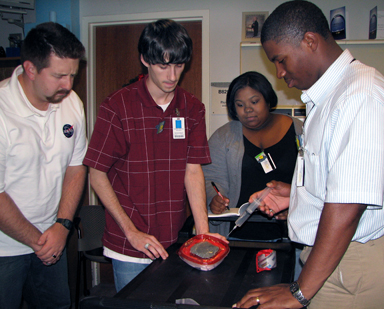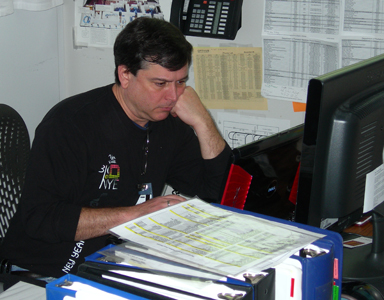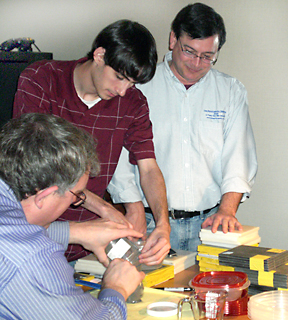Moon Water Discovery Opens New Doors 
PVAMU Scientists Add “Moon Mud” To Radiation Studies
Barely two months after NASA intentionally crashed the Lunar Crater Observation and Sensing Satellite (LCROSS) into the moon’s southern polar region and discovered water, faculty and student researchers from the NASA Center for Radiation Engineering and Science for Space Exploration (CRESSE) at Prairie View A&M University are already investigating how moisture content might alter the radiation shielding properties of various building materials in space.
CRESSE scientists and students used the high-energy proton beam at Loma Linda University Medical Center in December to simulate space radiation during an all-night, 11-hour test of prototype bricks made of regolith – simulated “moon dirt” – bound by high density polyethylene that shows promise as an effective shield to protect astronauts and their equipment against harmful space radiation. They may have also created the first-ever batch of “moon mud” used for radiation research.
The regolith, chemically engineered by NASA to match real moon dirt returned to earth by Apollo 11 astronauts, is mixed, compressed in a hydraulic press and dried into stiff plates or bricks at the university for easy assembly into modules of varying thicknesses at the proton beam site. Similar materials were used in September during CRESSE radiation experiments using the neutron beam at Los Alamos Neutron Science Center (LANCE).
November’s confirmation by NASA of water on the moon added a new research element to the CRESSE radiation measurements agenda, raising the question of how the moisture content of potential human habitat construction materials might impact its radiation shielding properties.
Lead Researcher Dr. Brad Gersey and Center Director Dr. Richard Wilkins jumped at the chance to modify their Loma Linda beam testing schedule to include proton bombardment of a regolith module injected with liquid water in a similar proportion to that found on the moon.
A NASA LCROSS website provided an estimate of 2% volume of water by weight in the regolith. Wilkins and Gersey had their student researchers calculate the amount of water needed to provide the same ratio for the Loma Linda experiment in a given amount of simulated regolith.PVAMU graduate students Jullian Norman and Ijette Foley, guided by Dr. Jianren Zhou, who leads the materials engineering core component of CRESSE research; and Gersey’s undergraduate research assistant, Jordan Fuchs, assembled an assortment of plastic materials into a suitable beam line container for the dry regolith, then metered the calculated amount of water into the apparatus with a large medical syringe volunteered by the biomedical branch of the Loma Linda Proton Treatment and Research Center in California.The result was a slightly “damp” regolith compound sandwiched in lightweight plastic and encased around its outside edges by a small plastic frame. The moistened target was then subjected to the same beam energies used on the dry regolith.
Gersey, who earlier expressed optimism about the physics indicating that damp regolith should shield better than dry regolith, said data from the test was “exciting,” if not yet conclusive. “Preliminary data analysis indicates that the shielding ability of wet regolith is superior to dry,” he said. “In fact, we’re finding that a small change in water content can make a big difference in shielding efficiency.”
The scientist said further analysis and more research are needed. That process could begin as early as February with the return of the research team to Loma Linda. Gersey said it will take at least one more experiment to give researchers the data they need to help NASA decide if planners need to place the habitat in a shallow, damp crater or build at a dryer, deeper location. “The answer might be a combination of the two approaches to optimize radiation protection,” Gersey said.
PVAMU scientists are in year two of a five-year NASA assignment to help develop construction “bricks” with effective shielding properties that can be used to build a habitat for humans on the moon using readily available on-site (in situ) materials.
On November 13, NASA scientists crashed the LCROSS into the permanently shadowed Cabeus crater ejecting a debris cloud containing at least 25 gallons of water. The LCROSS spectrometer instrument examined light absorbed by the dust particles from the impact crater to determine the existence of water and other substances, confirming the Indian space mission discovery in September which found small amounts of water in the lunar soil.
NASA scientists are hailing the discovery of water as a huge boost for prospects of a future human lunar habitat since it could be used as a potential source of drinking water, breathable oxygen and hydrogen for fuel. PVAMU research also suggests the use of water as an available resource to help shape moon dirt into bricks and construction blocks for above and below ground construction on the moon.
“The LACROSS findings have tremendous potential for the idea of human habitats on the moon and, eventually, on Mars,” Gersey said. “It will save millions of dollars and make space exploration possible on a much larger scale. Suddenly, you have the true potential for a safe and sustainable off-world colony using solar energy for power and hydroponics to grow food.”
“It costs about $100,000 to transport a pound of stuff like regolith or water to the moon,” Wilkins said. “If there’s enough of it already up there, then we’ve gone a long way toward finding a practical way to put astronauts on the moon for extended lengths of time. We concentrate on the radiation problem, but the LACROSS discovery may help solve many problems for exploration of the moon’s surface, which is turning out to be a more interesting place than we thought even a year ago.
“Interest in CRESSE radiation shielding research is reflected by the publication of information about the Loma Linda experiment that appeared in the on-line SpaceDaily.com and MoonDaily.com (Space Media Network) and was picked up by science and space related media around the globe.CRESSE regolith research has attracted space community recognition in a few unexpected ways. During earlier neutron beam experiments at LANCE, more than a few high profile researchers working on other projects showed an unexpected curiosity with CRESSE moon dirt, sifting the powder-like artificial moon material through their fingers like youngsters playing in a sand box. Visitors to the CRESSE facilities at Prairie View have also shown a similar fascination.Interest could peak again when the CRESSE beam team mixes up their next batch of “moon mud.”


